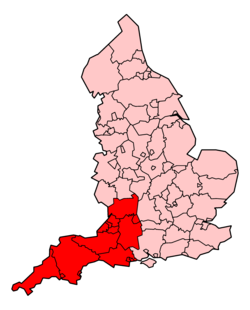| South Western Ambulance Service NHS Foundation Trust | |
|---|---|
| SWASFT | |
 | |
 Regions served by South Western Ambulance Service | |
| Type | NHS foundation trust |
| Established | 1 July 2006 (Cornwall, Devon, Dorset and Somerset) 1 February 2013 (merged with Great Western Ambulance Service) |
| Headquarters | Exeter |
| Region served | Bath and North East Somerset, Bournemouth, Christchurch and Poole Council, Bristol, Cornwall, Devon, Dorset, Gloucestershire, North Somerset, Plymouth, Isles of Scilly, Somerset, South Gloucestershire, Swindon, Torbay and Wiltshire |
| Area size | 10,000 square miles (26,000 km2)[1] |
| Population | 5.5 million (2018)[1] |
| Establishments | 96 Ambulance stations |
| Budget | £227.6 million (planned, 2018–19)[1] |
| Chair | Martin Holloway (Interim) [2] |
| Chief executive | Dr John Martin[3] |
| Website | www |
The South Western Ambulance Service NHS Foundation Trust (SWASFT) is the organisation responsible for providing ambulance services for the National Health Service (NHS) across South West England. It serves the council areas of Bath and North East Somerset, Bournemouth, Christchurch and Poole Council, Bristol, Cornwall, Devon, Dorset, Gloucestershire, North Somerset, Plymouth, Isles of Scilly, Somerset, South Gloucestershire, Swindon, Torbay and Wiltshire.[4]
On 1 March 2011, SWASFT was the first ambulance service in the country to become a NHS foundation trust. On 1 February 2013, the former Great Western Ambulance Service merged with the trust.[5]
SWASFT serves a population of more than 5.5 million,[1] and its area is estimated to receive an influx of over 17.5 million visitors each year. The operational area is predominantly rural but also has large urban centres including Bristol, Plymouth, Exeter, Truro, Bath, Swindon, Gloucester, Bournemouth and Poole.[6]
The service is headquartered in Exeter, Devon. It has 96 ambulance stations and six charity-operated air ambulance bases within its area. The chief executive is John Martin.[3]
The trust's core operations include:[7][6]
- Emergency ambulance 999 services
- Urgent Care Services (UCS) – GP out-of-hours medical care (Dorset)
- Tiverton Urgent Care Centre.

It is one of the ambulance trusts providing England with emergency medical services, and employs around 4,500 mainly clinical and operational staff (including Paramedics, Emergency Care Practitioners, Advanced Technicians, Emergency Care Assistants, Ambulance Care Assistants and Nurse Practitioners).[1] In addition there are around 3,200 volunteers including community first responders, BASICS doctors, fire service co-responders and patient transport drivers.
- ^ a b c d e Cite error: The named reference
:0was invoked but never defined (see the help page). - ^ "Martin Holloway | Our Board".
- ^ a b "Welcome to Our Board". SWAST. Retrieved 27 January 2024.
- ^ "What we do". South Western Ambulance Service. Retrieved 6 July 2014.
- ^ "Single trust formed after South West ambulance merger". BBC News. February 2013. Retrieved 30 December 2017.
- ^ a b "About Us". South Western Ambulance Trust. Retrieved 30 December 2017.
- ^ "South Western Ambulance Service NHS Foundation Trust". NHS Choices. Retrieved 30 December 2017.